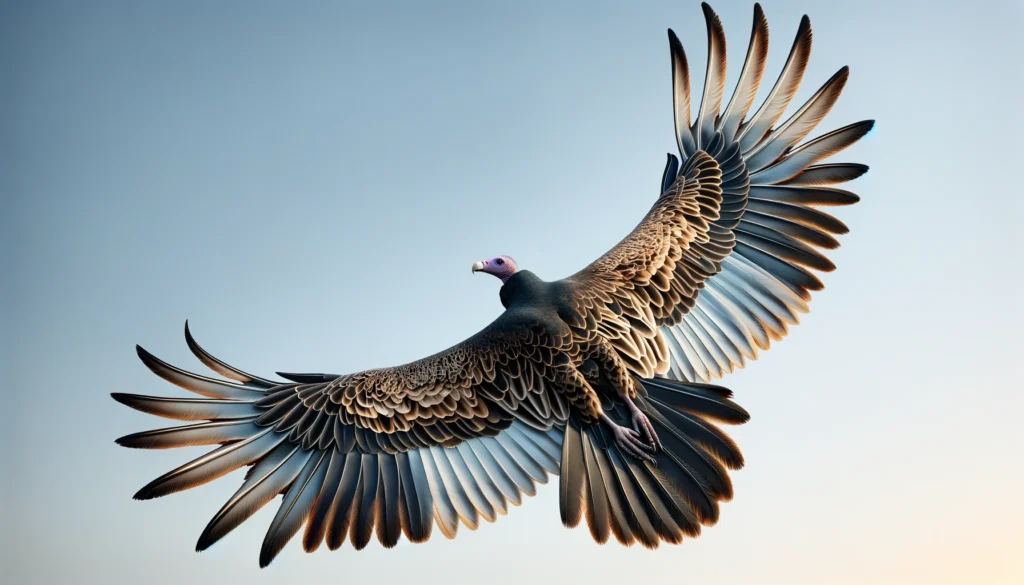Turkey Vulture vs Eagle – Did you know that the wingspan of an eagle can reach up to an astonishing 7.5 feet? Now, imagine comparing that to the wingspan of a turkey vulture. These two birds of prey may share some similarities, but their differences are truly fascinating.
Key Takeaways:
- Turkey vultures and eagles have distinct differences in their wingspans, with eagles having larger wingspans averaging 6 to 7.5 feet, while turkey vultures measure around 5 to 6 feet.
- Female bald eagles are generally larger than male bald eagles, including their wingspans, while male and female turkey vultures are similar in size.
- Bald eagles found in Alaska tend to have larger wingspans compared to their counterparts in other regions, while turkey vultures exhibit more consistent wingspans across different geographic regions.
- Eagles have wings built for power and hunting, allowing them to reach impressive speeds and capture prey with precision. Turkey vultures, on the other hand, have wings adapted for efficient soaring and gliding, conserving energy while covering large areas.
- Understanding the unique traits and behaviors of these majestic birds of prey can deepen our appreciation for the natural world.
Wingspan Comparison: Turkey Vulture and Eagle
When we look at the wingspans of turkey vultures and eagles, we find some cool differences. Bald eagles have a wingspan that ranges from 6 to 7.5 feet, making them larger on average compared to turkey vultures, which have a wingspan of about 5 to 6 feet. These sizes can change depending on the bird’s gender, age, and where they live.
Bald eagles have wings that are great for flying high and hunting. They can glide smoothly through the air and dive quickly to grab fish or small animals, thanks to their large wingspan. This lets them travel far and fast.
Turkey vultures however, have wings that are built differently. Their wings are longer and skinnier, perfect for gliding on warm air currents without using much energy. This helps them travel over large areas easily to find dead animals to eat.
In short, while both turkey vultures and eagles have impressive wingspans, their wings are built for different purposes. Bald eagles use their big wings to hunt efficiently, and turkey vultures use their unique wings for easy gliding and finding food without much work.
Gender Differences: Turkey Vulture and Eagle

When examining the gender differences between turkey vultures and eagles, we find distinct variations in size and wingspan. Female bald eagles, for instance, are generally larger than their male counterparts, including their wingspans. Female bald eagles have an impressive wingspan ranging from 6 to 7.5 feet, while males have a slightly smaller wingspan of 5.5 to 6.5 feet.
On the other hand, male and female turkey vultures exhibit more similarity in size. Both genders have an average wingspan of approximately 5.5 to 6.5 feet, solidifying their equality in terms of physical dimensions.
The contrasting gender differences in bald eagles are not only limited to wingspan but can also extend to overall body size and appearance. Female bald eagles tend to be larger and bulkier, with more substantial beaks and bodies compared to males.
These gender disparities highlight the unique characteristics of these birds of prey, providing valuable insights into their reproductive strategies and evolutionary adaptations.
| Bald Eagle | Turkey Vulture | |
|---|---|---|
| Female Wingspan | 6 to 7.5 feet | N/A |
| Male Wingspan | 5.5 to 6.5 feet | 5.5 to 6.5 feet |
| Female Body Size | Larger and bulkier | N/A |
| Male Body Size | Smaller and lighter | N/A |
This captivating image showcases the gender differences between a male and female bald eagle perched on a branch. The impressive wingspan of the female eagle is evident, emphasizing the distinct physical characteristics exhibited by the genders.
Geographic Variations: Turkey Vulture VS Eagle
When comparing turkey vultures and eagles, it is important to consider the geographic variations within these species. The location plays a significant role in determining certain characteristics, such as size and wingspan.
One notable example is found in Alaska, where bald eagles can be found with larger wingspans compared to their counterparts in other regions. In this unique environment, some bald eagles have been observed with wingspans reaching up to 8 feet. The abundance of food sources and the need to cover larger distances likely contribute to the development of larger wingspans in Alaskan bald eagles.
On the other hand, turkey vultures show more consistent wingspans across different geographic regions. Whether they are found in Alaska or other parts of the United States, the average wingspan of turkey vultures typically ranges between 5.5 to 6.5 feet. This suggests that the wingspan of turkey vultures is less influenced by geographic variations and more dependent on their overall species traits.
To provide a visual comparison, the table below summarizes the average wingspans for both bald eagles and turkey vultures in different geographic regions:
| Species | Geographic Region | Average Wingspan (feet) |
|---|---|---|
| Bald Eagle | Alaska | Up to 8 |
| Other regions | 6 – 7.5 | |
| Turkey Vulture | All regions | 5.5 – 6.5 |
Differences in Wingspans
The variations in wingspan between bald eagles and turkey vultures are a result of their unique evolutionary adaptations. While the larger wingspan of bald eagles allows them to soar and hunt efficiently over vast distances, the consistent wingspan of turkey vultures reflects their specialization in gliding and scavenging.
Now that we have covered the geographic variations in wingspan, let’s move on to explore the gender differences between turkey vultures and eagles.
Utility for Hunting and Soaring: Turkey Vulture and Eagle

When it comes to hunting and soaring, both the turkey vulture and the eagle have unique adaptations that suit their specific lifestyles. The bald eagle, with its powerful wings and impressive diving abilities, is a formidable predator in the sky. Let’s take a closer look at the utility of hunting and soaring for both these birds of prey.
Bald Eagle: Wings of Power and Precision
The bald eagle, with its cool looks and amazing flying skills, has wings built for strength and catching food. It’s pretty big, with a wingspan of 6 to 7.5 feet, and it can dive super fast to grab prey with power and accuracy. This awesome bird can see fish from far away and can dive at speeds up to 100 miles per hour, making it a top predator in the rivers and lakes.
Its wings help it glide smoothly over large areas, using warm air currents and winds to fly without wasting much energy. The bald eagle’s sharp eyesight and strong wings make it really good at finding and catching its food. Whether it’s a fish jumping out of the water or a small animal running on the ground, the bald eagle is unbeatable at hunting.
Turkey Vulture: Wings of Efficiency
The turkey vulture might not be as good at hunting as the bald eagle, but its wings help it excel at scavenging. Its wings are longer and slimmer, designed for easy soaring and gliding. With a wingspan of 5 to 6 feet, it can catch warm air rising from the earth (thermal updrafts) to fly over large areas without using much energy.
Unlike the bald eagle, which hunts for its food, the turkey vulture mainly eats dead animals. It has a great sense of smell that helps it find these dead animals from far away. When it sees food, its wings help it smoothly go down and move through tight spots to get to its meal. The wings also make it easier for the turkey vulture to quickly start flying and land, which is important for getting to food fast.
Even though the turkey vulture isn’t a hunter like the bald eagle, its wings are just right for its way of finding food by scavenging. These birds are important for cleaning up the environment because they help break down dead animals.
| Bald Eagle | Turkey Vulture | |
|---|---|---|
| Wingspan | 6 to 7.5 feet | 5 to 6 feet |
| Main Hunting Technique | Dives and captures prey | Scavenges carrion |
| Speed | Up to 100 miles per hour | N/A |
| Flight Adaptation | Efficient soaring and hunting | Efficient soaring and scavenging |
Conclusion
To wrap things up, when we look at turkey vultures and eagles, it’s clear they’re quite different, especially in how they look and act. For starters, eagles have a bigger wingspan, about 6 to 7.5 feet, compared to the turkey vultures’ 5 to 6 feet. This shows us that they’ve evolved to hunt and fly in their own unique ways.
Another interesting point is that female eagles are usually bigger than the males, including having larger wingspans. But for turkey vultures, both males and females are pretty much the same size, with their wingspans averaging between 5.5 to 6.5 feet.
Where these birds live can also affect their size. For example, bald eagles living in Alaska can have wingspans as big as 8 feet, which is huge! Meanwhile, turkey vultures tend to have a more uniform wingspan, no matter where they’re found, usually between 5.5 and 6.5 feet.
Lastly, what they eat and how they fly also sets them apart. Eagles have strong wings perfect for hunting. They can see their prey from far away and swoop down at high speeds. Turkey vultures, on the other hand, are all about efficiency. Their wings are made for gliding on warm air currents to save energy, which helps them cover more ground when they’re searching for dead animals to eat.
We also have another article about black vulture vs turkey vulture.





